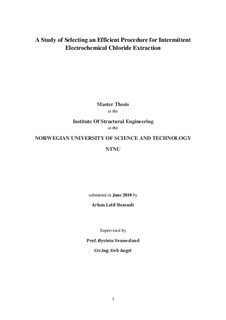| dc.description.abstract | In this eight specimens were prepared in laboratory. Four of the specimens were with w/cratio (0.4) and the other four specimens were with w/c ratio (0.5). All of the specimens were intentionally contaminated with 3% (by cement weight) of chlorides during the mixing process in order to study the effect of various parameters, like (current density, intermitting the current in different periods, and the w/c ratio), on the total efficiency of the ECE treatment. A titanium net, immersed in calcium hydroxide electrolyte solution, was used in this work, and the current densities were (0.7 and 1.0) A/m2 by steel surface. Two different current-on intervals (12 and 5) days were used as well, while the current-off interval was 2 day in all cases of treatment. The plexiglass-spacers, which used between the anode net and the concrete surface in order to reduce the acidification of the concrete surface, result in lower efficiency of the ECE in the adjacent concrete surface above it. Keeping the concrete surface immersed in the electrolyte solution during all the treatment’s period led to diffusing a considerable amount of chlorides in these areas out of the concrete.
According to the overall results of the chloride measurement; the 12 days of current-on treatment was most efficient in the early stage of the intermittent treatment, while the 5 days of current-on treatment was most efficient in the advanced stages of the intermittent treatment. Therefore, it can be beneficial to apply the ECE with gradient current-on intervals that starts with long intervals and ends with short intervals. Due to the low current densities that used, the total duration of the treatment was rather long (90 days) and the ECE treatment was most efficient in the specimens that treated with 1.0 A/m2 by steel surface.
The variation between the two types of w/c ratios that used in this work was low and therefore, the influence of the w/c ratio on the ECE’s efficiency was difficult to be noticed.
At the end of the treatment, the rates of extracted chlorides were generally between (80 and86)% in all the specimens excepting two of them which had two parameters in common (current density 0.7 A/m2 and 5 days of current-on intervals). These two specimens gave worst result and only about 66% of chlorides were extracted at the end of the treatment. | nb_NO |
